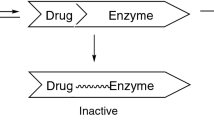Abstract
A considerable amount of information has been obtained about human enzymes involved in drug metabolism. Cytochrome P450 is presented as a paradigm in order to illustrate the experimental techniques now available.In vitro assays can be done with tissue slices, microsomes, or even short-term cell cultures. In addition, recombinant enzymes can be produced in a variety of different vector systems. Information about catalytic selectivity regarding new drugs can be obtained, as well as important information about potential drug-drug interactions and bioavailability. Such studies play a role in the drug development process as well as metabolism and safety assessment.
Similar content being viewed by others
References
F. P. Guengerich. Human cytochrome P450 enzymes. In P. R. Ortiz de Montellano (ed.),Cytochrome P450, Plenum Press, New York, 1995, pp. 473–535.
F. P. Guengerich. History, overview, and significance. In F. P. Guengerich (ed.),Biotransformation, Vol. 3, Comprehensive Toxicology, Pergamon, New York, 1997, in press.
M. S. Denison and J. P. Whitlock. Xenobiotic-inducible transcription of cytochrome P450 genes.J. Biol. Chem. 270:18175–18178 (1995).
M. R. Waterman and F. P. Guengerich. Enzyme regulation. In F. P. Guengerich (ed.),Biotransformation, Vol. 3, Comprehensive Toxicology, Pergamon, New York, 1996, in press.
A. Guillouzo, F. Morel, O. Fardel, and B. Meunier. Use of human hepatocyte cultures for drug metabolism studies.Toxicology 82:209–219 (1993).
P. S. Guzelian, D. Li, E. G. Schuetz, P. Thomas, W. Levin, A. Mode, and J. Å. Gustafsson. Sex change in cytochrome P-450 phenotype by growth hormone treatment of adult rat hepatocytes maintained in a culture system on matrigel.Proc. Natl. Acad. Sci. U.S. 85:9783–9787 (1988).
J. A. Halpert and F. P. Guengerich. Enzyme inhibition and stimulation. In F. P. Guengerich (ed.),Biotransformation, Vol. 3, Comprehensive Toxicology, Pergamon, New York, 1997, in press.
R. B. Silverman. Mechanism-based enzyme inactivators.Meth. Enzymol. 249:240–283 (1995).
F. P. Guengerich and T. Shimada. Oxidation of toxic and carcinogenic chemicals by human cytochrome P-450 enzymes.Chem. Res. Toxicol. 4:391–407 (1991).
D. G. Bailey, J. D. Spence, C. Munoz, and J. M. O. Arnold. Interaction of citrus juices with felodipine and nifedipine.Lancet 337:268–269 (1991).
F. P. Guengerich and D-H. Kim.In vitro inhibition of dihydropyridine oxidation and aflatoxin B1 activation in human liver microsomes by naringenin and other flavonoids.Carcinogenesis 11:2275–2279 (1990).
U. Thull and B. Testa. Screening of unsubstituted cyclic compounds as inhibitors of monoamine oxidases.Biochem. Pharmacol. 47:2307–2310 (1994).
P. E. Thomas, A. Y. H. Lu, S. B. West, D. Ryan, G. T. Miwa, and W. Levin. Accessibility of cytochrome P450 in microsomal membranes: Inhibition of metabolism by antibodies to cytochrome P450.Mol. Pharmacol. 13:819–831 (1977).
H. V. Gelboin. Cytochrome P450 and monoclonal antibodies.Pharmacol. Rev. 45:413–453 (1993).
P. Beaune, P. G. Kremers, L. S. Kaminsky, J. de Graeve, and F. P. Guengerich. Comparison of monooxygenase activities and cytochrome P-450 isozyme concentrations in human liver microsomes.Drug Metab. Dispos. 14:437–442 (1986).
R. Peter, R. G. Böcker, P. H. Beaune, M. Iwasaki, F. P. Guengerich, and C-S. Yang. Hydroxylation of chlorozoxazone as a specific probe for human liver cytochrome P-450 IIE1.Chem. Res. Toxicol. 3:566–573 (1990).
F. P. Guengerich, D-H. Kim, and M. Iwasaki. Role of human cytochrome P-450 IIE1 in the oxidation of many low molecular weight cancer suspects.Chem. Res. Toxicol. 4:168–179 (1991).
F. J. Gonzalez, T. Aoyama, and H. V. Gelboin. Expression of mammalian cytochrome P450 using vaccinia virus.Meth. Enzymol. 206:85–92 (1991).
F. J. Gonzalez, S. Kimura, S. Tamura, and H. V. Gelboin. Expression of mammalian cytochrome P450 using baculovirus.Meth. Enzymol. 206:93–99 (1991).
C. L. Crespi. Expression of cytochrome P450 cDNAs in human B lyphoblastoid cells: Applications to toxicology and metabolite analysis.Meth. Enzymol. 206:123–129 (1991).
F. P. Guengerich, W. R. Brian, M-A. Sari, and J. T. Ross. Expression of mammalian cytochrome P450 enzymes using yeast-based vectors.Meth. Enzymol. 206:130–145 (1991).
J. P. Renaud, M. A. Peyronneau, P. Urban, G. Truan, C. Cullin, D. Pompon, P. Beaune, and D. Mansuy. Recombinant yeast in drug metabolism.Toxicology 82: 39–52 (1993).
H. J. Barnes, M. P. Arlotto, and M. R. Waterman. Expression and enzymatic activity of recombinant cytochrome P450 17α-hydroxylase inEscherichia coli.Proc. Natl. Acad. Sci. U.S. 88:5597–5601 (1991).
F. P. Guengerich, E. M. J. Gillam, and T. Shimada. New applications of bacterial systems to problems in toxicology.Crit. Rev. Toxicol. 26:551–583 (1996).
R. Thier, S. E. Pemble, J. B. Taylor, W. G. Humphreys, M. Persmark, B. Ketterer and F. P. Guengerich. Expression of mammalian glutathioneS-transferase 5-5 inSalmonella typhimurium TA1535 leads to base-pair mutations upon exposure to dihalomethanes.Proc. Natl. Acad. Sci. U.S. 90:8576–8580 (1993).
R. Thier, S. Pemble, H. Kramer, J. B. Taylor, F. P. Guengerich, and B. Ketterer. Human glutathioneS-transferase T1-1 enhances mutagenicity of 1,2-dibromoethane, dibromomethane, and 1,2,3,4-diepoxybutane inSalmonella typhimurium.Carcinogenesis 17: 163–166 (1996).
F. P. Guengerich. Cytochrome P-450 enzymes and drug metabolism. In J. W. Bridges, L. F. Chasseaud, and G. G. Gibson (eds.),Progress in Drug Metabolism, Vol. 10, Taylor and Francis, London, 1987, pp. 1–54.
M. E. Andersen, H. J. Clewell, III, M. L. Gargas, F. A. Smith, and R. H. Reitz. Physiologically based pharmacokinetics and the risk assessment process for methylene chloride.Toxicol. Appl. Pharmacol. 87:185–205 (1987).
R. H. Reitz, A. Mendrala, and F. P. Guengerich.In vitro metabolism of methylene chloride in human and animal tissues: Use in physiologically-based pharmacokinetic models.Toxicol. Appl. Pharmacol. 97:230–246 (1989).
Author information
Authors and Affiliations
Rights and permissions
About this article
Cite this article
Guengerich, F.P. In Vitro techniques for studying drug metabolism. Journal of Pharmacokinetics and Biopharmaceutics 24, 521–533 (1996). https://doi.org/10.1007/BF02353478
Published:
Issue Date:
DOI: https://doi.org/10.1007/BF02353478




